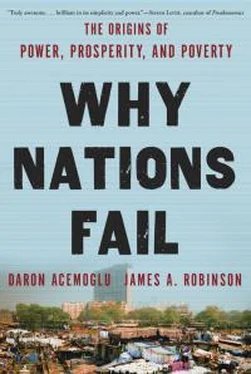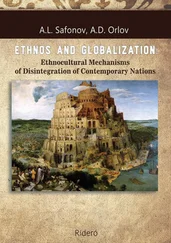Stalin understood that in the Soviet economy, people had few incentives to work hard. A natural response would have been to introduce such incentives, and sometimes he did—for example, by directing food supplies to areas where productivity had fallen—to reward improvements. Moreover, as early as 1931 he gave up on the idea of creating “socialist men and women” who would work without monetary incentives. In a famous speech he criticized “equality mongering,” and thereafter not only did different jobs get paid different wages but also a bonus system was introduced. It is instructive to understand how this worked. Typically a firm under central planning had to meet an output target set under the plan, though such plans were often renegotiated and changed. From the 1930s, workers were paid bonuses if the output levels were attained. These could be quite high—for instance, as much as 37 percent of the wage for management or senior engineers. But paying such bonuses created all sorts of disincentives to technological change. For one thing, innovation, which took resources away from current production, risked the output targets not being met and the bonuses not being paid. For another, output targets were usually based on previous production levels. This created a huge incentive never to expand output, since this only meant having to produce more in the future, since future targets would be “ratcheted up.” Underachievement was always the best way to meet targets and get the bonus. The fact that bonuses were paid monthly also kept everyone focused on the present, while innovation is about making sacrifices today in order to have more tomorrow.
Even when bonuses and incentives were effective in changing behavior, they often created other problems. Central planning was just not good at replacing what the great eighteenth-century economist Adam Smith called the “invisible hand” of the market. When the plan was formulated in tons of steel sheet, the sheet was made too heavy. When it was formulated in terms of area of steel sheet, the sheet was made too thin. When the plan for chandeliers was made in tons, they were so heavy, they could hardly hang from ceilings.
By the 1940s, the leaders of the Soviet Union, even if not their admirers in the West, were well aware of these perverse incentives. The Soviet leaders acted as if they were due to technical problems, which could be fixed. For example, they moved away from paying bonuses based on output targets to allowing firms to set aside portions of profits to pay bonuses. But a “profit motive” was no more encouraging to innovation than one based on output targets. The system of prices used to calculate profits was almost completely unconnected to the value of new innovations or technology. Unlike in a market economy, prices in the Soviet Union were set by the government, and thus bore little relation to value. To more specifically create incentives for innovation, the Soviet Union introduced explicit innovation bonuses in 1946. As early as 1918, the principle had been recognized that an innovator should receive monetary rewards for his innovation, but the rewards set were small and unrelated to the value of the new technology. This changed only in 1956, when it was stipulated that the bonus should be proportional to the productivity of the innovation. However, since productivity was calculated in terms of economic benefits measured using the existing system of prices, this was again not much of an incentive to innovate. One could fill many pages with examples of the perverse incentives these schemes generated. For example, because the size of the innovation bonus fund was limited by the wage bill of a firm, this immediately reduced the incentive to produce or adopt any innovation that might have economized on labor.
Focusing on the different rules and bonus schemes tends to mask the inherent problems of the system. As long as political authority and power rested with the Communist Party, it was impossible to fundamentally change the basic incentives that people faced, bonuses or no bonuses. Since its inception, the Communist Party had used not just carrots but also sticks, big sticks, to get its way. Productivity in the economy was no different. A whole set of laws created criminal offenses for workers who were perceived to be shirking. In June 1940, for example, a law made absenteeism, defined as any twenty minutes unauthorized absence or even idling on the job, a criminal offense that could be punished by six months’ hard labor and a 25 percent cut in pay. All sorts of similar punishments were introduced, and were implemented with astonishing frequency. Between 1940 and 1955, 36 million people, about one-third of the adult population, were found guilty of such offenses. Of these, 15 million were sent to prison and 250,000 were shot. In any year, there would be 1 million adults in prison for labor violations; this is not to mention the 2.5 million people Stalin exiled to the gulags of Siberia. Still, it didn’t work. Though you can move someone to a factory, you cannot force people to think and have good ideas by threatening to shoot them. Coercion like this might have generated a high output of sugar in Barbados or Jamaica, but it could not compensate for the lack of incentives in a modern industrial economy.
The fact that truly effective incentives could not be introduced in the centrally planned economy was not due to technical mistakes in the design of the bonus schemes. It was intrinsic to the whole method by which extractive growth had been achieved. It had been done by government command, which could solve some basic economic problems. But stimulating sustained economic growth required that individuals use their talent and ideas, and this could never be done with a Soviet-style economic system. The rulers of the Soviet Union would have had to abandon extractive economic institutions, but such a move would have jeopardized their political power. Indeed, when Mikhail Gorbachev started to move away from extractive economic institutions after 1987, the power of the Communist Party crumbled, and with it, the Soviet Union.
THE SOVIET UNION was able to generate rapid growth even under extractive institutions because the Bolsheviks built a powerful centralized state and used it to allocate resources toward industry. But as in all instances of growth under extractive institutions, this experience did not feature technological change and was not sustained. Growth first slowed down and then totally collapsed. Though ephemeral, this type of growth still illustrates how extractive institutions can stimulate economic activity.
Throughout history most societies have been ruled by extractive institutions, and those that have managed to impose some extent of order over the countries have been able to generate some limited growth—even if none of these extractive societies have managed to achieve sustained growth. In fact, some of the major turning points in history are characterized by institutional innovations that cemented extractive institutions and increased the authority of one group to impose law and order and benefit from extraction. In the rest of this chapter, we will first discuss the nature of institutional innovations that establish some degree of state centralization and enable growth under extractive institutions. We shall then show how these ideas help us understand the Neolithic Revolution, the momentous transition to agriculture, which underpins many aspects of our current civilization. We will conclude by illustrating, with the example of the Maya city-states, how growth under extractive institutions is limited not only because of lack of technological progress but also because it will encourage infighting from rival groups wishing to take control of the state and the extraction it generates.
ON THE BANKS OF THE KASAI
Читать дальше












